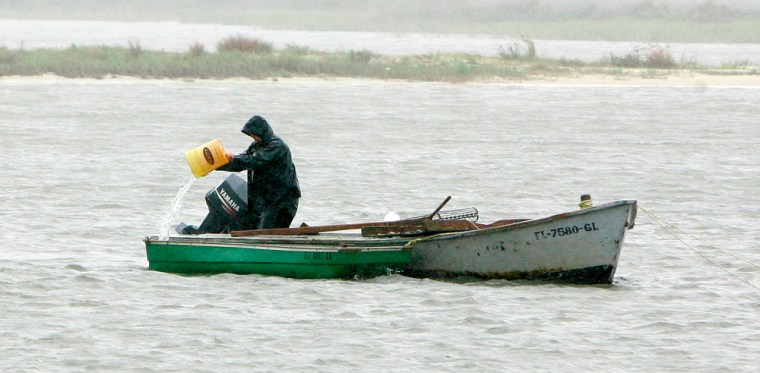Tropical Storm Fay was downgraded to a tropical depression Saturday night, but cities along the Gulf Coast were still bracing for heavy rain.
As a tropical storm, Fay set a record with four landfalls in Florida and was blamed for at least 11 deaths there and another in Georgia, emergency officials said.
Though the storm weakened as it traveled inland Saturday, with maximum sustained winds of about 35 mph, cities from Pensacola to New Orleans were still preparing for possible flooding. Forecasters said areas from the Florida panhandle to eastern Louisiana could get 6 to 12 inches of rain before the storm was over. Isolated tornadoes were also possible.
"People automatically assume that if it weakens, the hazards go down with it, but in the case of rainfall, it's not a function of wind speed," said Jamie Rhome of the National Hurricane Center. "Slow moving systems dump a lot of rainfall."
At 11 p.m. EDT, the tropical depression was 30 miles north-northeast of Pensacola and 60 miles east-northeast of Mobile, Ala. It was moving west at 8 mph.
Depression could stall Monday
The forecast indicates the depression could slow in the next few days and possibly stall Monday over southern Mississippi or eastern Louisiana, Rhome said. It was expected to bring heavy rain to southern Alabama and Mississippi on Sunday.
The U.S. Coast Guard in Mobile, Ala., closed numerous ports and waterways between Panama City in Florida and the Alabama coast to the east.
In Alabama, officials opened shelters in the coastal counties of Mobile and Baldwin for people in low-lying areas. Trucks capable of rescuing people from floodwaters were also in place, said Yasamie Richardson, spokeswoman for the Alabama Emergency Management Agency.
In the New Orleans area, which is approaching the third anniversary of Hurricane Katrina, forecasts called for several inches of rain on the south shore of Lake Pontchartrain. In St. Bernard Parish, site of some of the worst post-Katrina flooding, emergency officials were handing out sandbags Saturday.
City officials in Slidell, La., said emergency vehicles had been fueled and workers were on call.Sandbags were also distributed in Ocean Springs, Gulfport and Biloxi on the Mississippi coast. The Air Force Reserve's 403rd Wing evacuated aircraft Saturday from Keesler Air Force Base in Mississippi to locations in South Florida and Texas. The 403rd includes planes known as "hurricane hunters" that officials said would be available to continue to monitor Fay.
The Gulf Islands National Seashore closed a campground area and four barrier islands to the public.
Florida homes flooded out
Thousands of homes and businesses in Florida were inundated with flood waters this week as the storm worked its way north from its first landfall in the Florida Keys and zigzagged across the peninsula.
Fay's center made its fourth landfall early Saturday about 15 miles north-northeast of Apalachicola, according to the National Hurricane Center.
Rains and strong wind gusts blitzed Tallahassee, the state capital, for more than 24 hours, knocking down trees and power lines and cutting electricity to more than 12,000 customers, city officials said.
In southwest Georgia, officials said a boy drowned Saturday while playing in a drainage ditch swollen by 10 to 12 inches of rain.
His death, along with the 11 deaths in Florida, bring the toll from Fay to at least 35. A total of 23 died in Haiti and the Dominican Republic from flooding.
Fay's wake caused widespread flooding along Florida's east coast, especially in Jacksonville near the storm's third landfall.
The Office of Insurance Regulation reported Saturday that roughly 6,700 homeowners filed claims, although only some were because of flooding.
Florida disaster status sought
Gov. Charlie Crist has asked the federal government to declare the worst-hit areas major disaster areas.
Fay had been an unusual storm since it was named Aug. 15. After hitting the Keys Monday, it crossed open water again before hitting a second time near Naples on the southwest coast. It limped across the state, popped back out into the Atlantic Ocean and struck again near Flagler Beach on the central eastern coast. It was the first storm in almost 50 years to make three landfalls in the state as a tropical storm. Its fourth landfall as such was the first in recorded history.
"This is unprecedented in terms of the slow nature of this storm, the large circulation and the fact that it's impacted probably about 90 percent of the state with heavy rains and severe weather," state meteorologist Ben Nelson said.
